October Big Day, October 17, 2020, is 24 hours to celebrate birds near us and around the world. In addition, the objective is to help the Global Bird Weekend during October 17 and 18 to draw attention to the illegal trafficking of bird species.
The Global Bird Weekend is the brainchild of Tim Appleton, creator of England’s most famous nature reserve, RutLand Water. He is co-founder of the International Bird Watching Fair, and vice-president of the British Ornithologists’ Union, recognized by the British Order of the highest excellence for his work in conservation.

“In Colombia, so far, there are 275 species of migratory birds that make their transit through the country, through routes can be long distance latitudinal, transboundary and local, according to the Ministry of Environment and Sustainable Development…About 154 of these migratory species come from the northwest, central or eastern North America,”
The goal was to gather more than 25,000 observers by submitting lists to Ebird on October 17.
In the Madhú Nature Reserve we form a team of professionals with the purpose of recording and enjoying representative species, covering the entire altitudinal range of the reserve. In previous years, we participated prioritizing the number of species and the largest number of lists, this year we focused more on the search for representative species, not so common and to make a better photographic record of the birds inhabitants and visitors to the reserve.
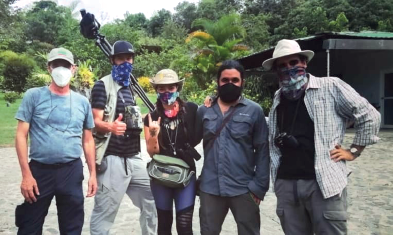
On this occasion, the team was formed by:
- Emilio Constantino
- Manuel Espejo
- Martin Mejia
- Alejandro Escobar
- Omar Botina
- Bali Rodriguez.
On Saturday, October 17, at 5 a.m., we started with the song count at Casa Madhú at 1,200 m.a.s.l. You can feel the morning awakening with the abundance of songs from Little Tinamú, along the tetimocha trail. We stayed until 9:30 a.m. in the gardens of Casa Madhú. In front of Casa Madhú, in the pastures of Ingenio Providencia, a pair of Pyrocephalus is presented in reproductive behavior among a chiminango that is part of the biological corridor that the Madhú Natural Reserve intends to recover with the geographic valley of the Cauca River. In a Palma botella that has been occupied for generations by the Cocli (Buff necked Ibis), this time we found an individual possibly brooding in its nest.
We continue to Casa de Colores, to enjoy a snack and continue with the sighting in vehicles on the road. Feeding in one of the house’s drinking troughs, the Red Billed Emerald defends where we have been able to record its nest. Also the Short Tailed Hawk, being an uncommon raptor, descends from the top of the mountains making descending spirals, shows how the Casa de Colores is an excellent spot for raptor watching.
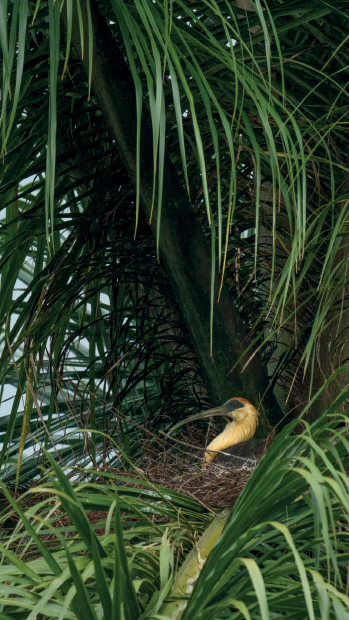
It was around 11 a.m. near the green gate, on a day with little activity, we began to see mixed flocks as we slowly climbed into the vehicles. We stopped when we heard another flock activity in the canopy. An explosion of little striped birds, arriving singing and happy, like new arrivals from North America in a feeding frenzy, a feast of insects. Among the warblers we distinguish Black and White Warbeler, Yellow Warbler, Blackburnian Warbler, also Summer Tanager and Hepatic Tanager. Among all of them, the behavior of one in particular, which foraged among the dry leaves, attracted attention. It was a Cerulean Warbler. It was the start of a race to differentiate a female Cerulean Warbler with faded plumage that closely resembles a Blackburnian Warbler with an untrained eye. After half an hour of action and many warblers, the whole group managed to observe the Cerulean Warbler and we managed to get a photographic record of this important boreal visitor. They had seen just before among the silhouettes of the trees in the sky, the Ospreys and Mississippi Kite.
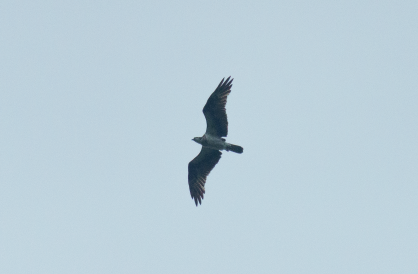
The Cerulean Warbler is the most rapidly declining Neotropical migratory bird, in addition to the many threats facing its wintering habitat in the northern Andes. The reinita depends on shade coffee during the winter, but this technique of coffee cultivation is disappearing due to fluctuating coffee prices that are driving farmers to change cultivation techniques to open field coffee. In the fragmented forests of the United States, it is vulnerable to parasitism by other birds, and populations of this bird are declining faster than all other North American warblers. By 2006 the population was only 20% of what it was 20 years ago.
Status and conservation.
American bird conservancy with the proaves foundation, work for the protection of the Cerulean warbler creating together the Cerulean Warbler Reserve, in San Vicente de Chucurí, Fundación Yotoco and Cerulean Warbler Wintering Ground Conservation Plan, CWWGP. Calling attention to promote alliances with these foundations for their protection and to obtain resources.
Another migratory warbler of interest is the Canada Warbler. It is a small boreal bird that spends summers in Canada and the northeastern United States and winters in South America. It is one of the last migratory birds to reach breeding grounds and is the first to leave. And they arrive in South America in late September and early October. It is a species included in several risk lists. Canadian warbler populations have declined by 70% in the last 50 years.
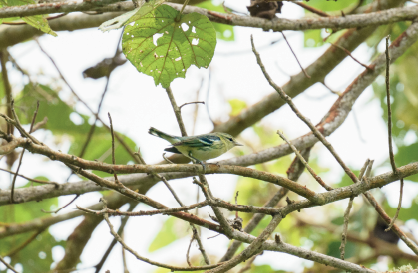
We arrived at around 12:30 to prepare some delicious sandwiches at Casa de La Brisas, while watching the now recurrent Schistes albigularis (Chocó Daggerbill) drilling the achiras and the Thlypopsis ornata (Rufous-chested Tanager) eating around the house, while the Rufous Collared Sparrow come in and out of the tall red aloe.
Following the afternoon hours, we started walking towards the circuit of the Bakery. There was a lot of stillness and silence, the birds did not sing much in the afternoon hours, but it was a beautiful hike, we enjoyed the neighboring trails, the rising mist and the silence on the mountain. Descending towards the Casa de las Brisas, as the sun was setting, we heard the song of the Golden-plumed Parrakeet landing on the giant Australian eucalyptus. Satisfied and grateful for the fruitful morning, and despite not having been focused on number of lists, we were able to place 1st in Valle del Cauca in number of birds for October Bird Day 2020 on Ebird.
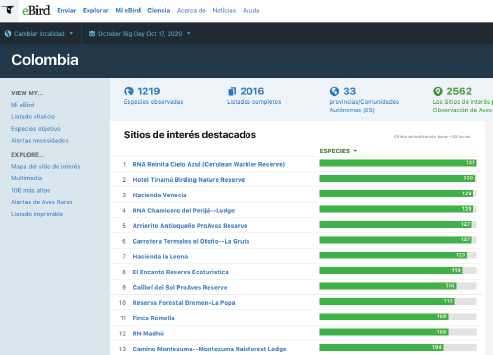


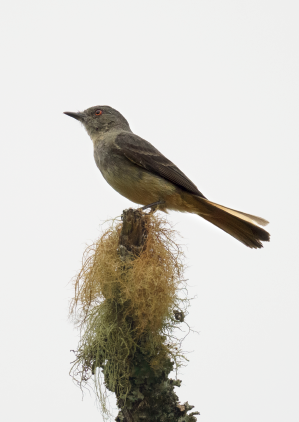
To continue with the Global Bird Weekend, on Sunday, October 18, we headed to the highest sector of the reserve. Located next to a Cera Palm (Ceroxilum ventricuosum) that was in fruit. At this point is where we took the route up, the sky was clear and the sun was warming the morning, we identified a pair of White-rumped Hawks in courtship flight and a solitary Broad-winged Hawk, thus discovering that this is also a good spot for raptor monitoring.
When we arrived at Baño de Brujo, a boundary between oak forests and pastures, it has its name because it is a place where the fog rises and makes it difficult to identify birds, in a moment it clears and we discovered next to us a Ruffus-tailed Tyrant, which caught everyone’s attention for being a tyrannid with an intense red iris. This bird thrilled us, as it is a new species for the reserve and Lifer for the whole group.
We continue climbing to the Mirador Madhú viewpoint, where from the ridge we have a spectacular view of the valley between the mountains of the central mountain range, and at this point you can see the formation of clouds in the basin of the mountains. Further on we found more humid trail areas with lichens and sphagnum, orchids and bromeliads…Among this beautiful flora, a Golden-fronted Redstart (Miyoborus ornatus) took the time to perch and sing for a few minutes, close enough to make an expressive and dynamic record.
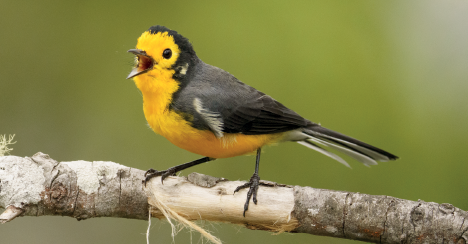
At the end of this hike up, at 2800 masl, in Cerro Corrientes, we heard the Andrean Pygmy Owl, a small owl that we had not seen for two years, this small predator that with its song alerts mixed flocks, also allowed itself to be photographed. Also, right on the ridge at the end of the ridge, in front of us, we could see a landscape of steep slopes and dense greenery, where we called out to the Black-billed Andean Toucan, who responded quickly to let the whole group see him perfectly.
We also achieved the first auditory records of birds in the Reserve with the following species:
We started the descent with a list of 43 species for the day, at a good pace through a threatening gray cloud, happy and grateful for a pleasant day.
- Sierran Eleanie
- Chestnut wood Quail
- Rufous-chested Tanager
- Andean Pygmy Owl
- Black-billed mountain Toucan

